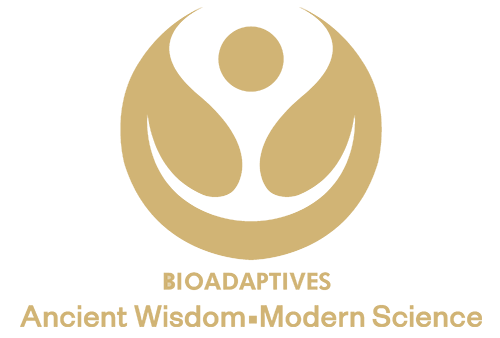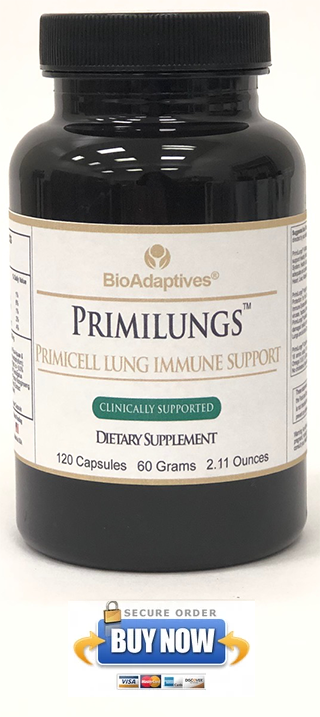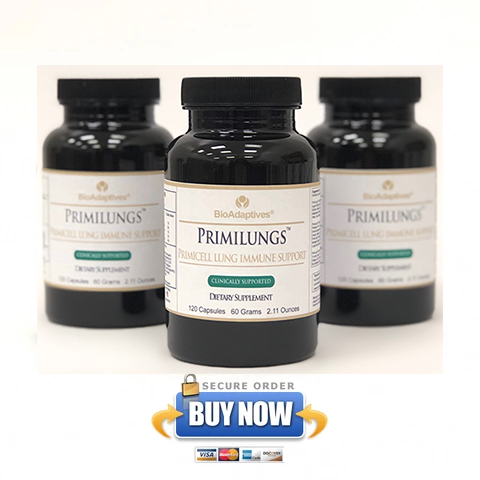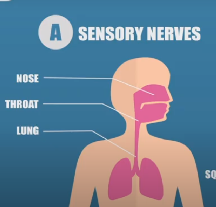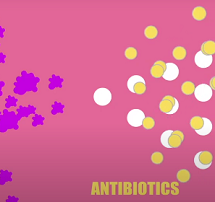INTRODUCING PRIMILUNGS™ AND THE HEALTH BENEFITS
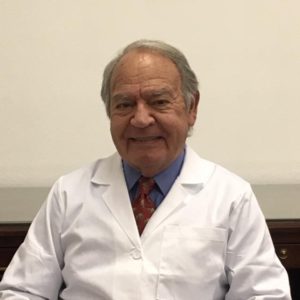
Edward E. Jacobs, Jr, MD (Dr Ted), a graduate of Princeton and Harvard Medical School, is a biotechnology consultant with over 25 years experience in biopharmaceutical and medical device development, as well as, 35 years of teaching and direct patient care. His drug development experience has involved international human and animal trials, including medical support for the FDA and global regulatory affairs. Dr. Jacobs received surgical training at Harvard and held research positions at the National Heart, Lung and Blood Institute, Bethesda, MD, and at St. Thomas’ Hospital Medical School, London. He has served as an Assistant Clinical Professor at Harvard Medical School, on the Scientific Advisory Board of the Armenise-Harvard Foundation and the Publications Committee for the New England Journal of Medicine. His current focus is on natural supplement formulations for human and animal use, anti-aging strategies, and primitive cell biology. He is an author of more than 40 scientific publications and is the holder of four patents.
PrimiLungs™: Dietary Supplement for Lung and Immune Support
Several natural ingredients are known to strengthen the immune system and to support healthy breathing. The ingredients are well documented, but the difficulty can be in choosing which ones to take.
Thankfully, that work has already been done for you.
PrimiLungs™ is a formulation of all-natural botanical ingredients designed to
Boost Immune System Defense
and
Promote the Lung’s Natural Resistance to Stress
PrimiLungs™ is an all-natural supplement consisting of a derivative blend of ingredients tested and utilized in humans and animals for the past five years where safety and efficacy were systematically demonstrated. No adverse effects have been observed or reported during testing, or by consumers, veterinarians, or health care providers.
Reported Effects in Humans
Generally, people notice an improvement within 1 to 2 weeks after consuming PrimiLungs™ on a daily basis. The majority of users experience a higher energy level, less fatigue, faster recovery from exercise, accelerated wound healing and elevation of mood. Increased hair and nail growth and improved hair and nail quality are also frequently reported. These effects are believed to be related, not only to the direct activity of the components in PrimiLungs™, but also to the activation of various primitive cells. Primitive cells, including stem cells and their derivatives, are found in the bone marrow and in every organ of the body. They act like a factory to produce immune cells and whatever specialized cells are needed to repair organs like the LUNGS, HEART and LIVER.

Reported Effects in Animals:
The ingredients found in PrimiLungs™ and derivative formulations have also been studied in horses and dogs where similar beneficial effects were seen.
Reported Effects in Horses
Performance horses were noted to have more energy, run faster, recover more quickly from extreme exercise and from fatigue related to being transported. In addition, they displayed accelerated wound healing, improved sleep patterns, greater manageability, and improved hair and hoof quality and growth.
Importantly, performance horses were perceived to have an increased resistance to Lung damage (bleeding) when stressed by extreme exercise. Exercise Induced Pulmonary Hemorrhage (EIPH) is a common condition seen in performance horses and it has also been seen in human athletes and greyhounds. The exact cause of EIPH is unknown but it is thought that Lung abnormal blood flow and excessive inflammation could be factors. Gynostemma, a natural adaptogenic supplement in PrimiLungs™, has been used for many years to regulate blood flow and help control Lung Inflammation.
Reported Effects in Dogs
Dogs were noted to have more energy (like a puppy), run faster, and recover more quickly from extreme exercise and from fatigue related to being transported. In addition, they displayed accelerated wound healing, improved sleep patterns, greater manageability, and improved hair and claws quality and growth.
Dogs, especially aging animals, of many breeds have shown a remarkable rejuvenation effect in addition to the benefits seen in horses. This effect, observed by owners and veterinarians, usually occurs within one week and is shown as a definite increase in energy, mobility, and cognition.
Here’s How PrimiLungs™ Can Help Strengthen Your Lungs and Immune System
PrimiLungs™ all-natural formula is designed to support healthy, functioning lungs and a strong immune system. Healthy lungs are necessary to maintain an adequate and continuous OXYGEN supply for the brain, heart, liver, kidneys, and other vital organs.
PrimiLungs™ helps the immune system to give critical protection for the lungs and other vital organs. The immune system detects and destroys harmful threats like viruses, bacteria, abnormal cells, and toxic substances.
PrimiLungs™ activates primitive cells that replace damaged cellular components of the immune system, lungs, and all other organs.
PrimiLungs™ contains 62 minerals and trace minerals, 18 amino acids, 10 vitamins, and 14 fatty acids including omega 3,5,6,7. It is gluten free, has no trans-fat, no cholesterol, no added sugar, and is non-GMO.
- Increases Lung Resistance to Damage and Stress
- Provides Immune System Support
- Naturally Increases the Activity of Your Own Regenerative Primitive Cells
- Provides Anti-inflammatory and Antioxidant Support
- Alleviates Depressive Mood
- Enhances Physical Performance, Recovery and Endurance
PrimiLungs™ is composed of:
• AFA (Aphanizomenon Flos-Aquae , Blue-Green Algae)
Aphanizomenon Flos-Aquae – a species of cyanobacteria (blue-green algae) – grows naturally in fresh water lakes and has been sold in the United States as a dietary supplement since the 1980s.
Aphanizomenon Flos-Aquae (AFA) is known to contain nutrients, including essential fatty acids, active enzymes, vitamins, amino acids, minerals, proteins, complex carbohydrates, and phytochemicals, and is marketed as a nutritional supplement. Consumers report increased energy, better hair and nail growth, improved wound healing and recovery from exercise, and elevation of mood.
An ethanol extract of AFA-cellular concentrate has been shown to increase stem cell proliferative action when incubated with human adult bone marrow cells or human CD34+ hematopoietic progenitors in culture. The preliminary study suggests that the ethanol extract of AFA cellular concentrate may act to promote proliferation of human stem cell populations.9
• Spirulina (Aphrospira platensis, Blue Green Algae)
Spirulina ( Arthrospira sp.), a spiral shaped cyanobacterium, classified as a blue-green microalgae, grows naturally in alkaline lakes and is commercially cultivated as a food source and natural supplement for humans and animals. It is nutrient rich, containing protein, all essential amino acids, vitamins and minerals. Importantly, spirulina is a significant source of omega acids (gamma-linoleic, palmitoleic, oleic) and carotenoids, including beta-carotene and phycocyanin.
An important component of spirulina is a protein-bound photosynthetic pigment called C-Phycocyanin, which has demonstrated anti-inflammatory, antioxidant, antitumor, and immune-stimulating properties. 34These effects are due, in part, to the phycocyanobilin constituent of C-Phycocyanin, similar to human bilirubin that functions to inhibit NADPH oxidase activity4,5
An anti-diabetic benefit of spirulina’s NAPDH oxidase inhibition is the decrease in the lipotoxic destruction of insulin producing pancreatic beta cells. The oxidative destruction of beta cells is thought to be involved in the occurrence of diabetes38
Numerous studies indicate that spirulina can contribute to the maintenance of good health especially related to aging. The phycocyanin in spirulina, a powerful antioxidant, helps to mitigate the harmful effects of oxygen radicals thought to play a central role in the aging process. In a double blindi placebo controlled study of aging Koreans, there was a significant reduction of inflammatory cytokines. Also, a reduction of serum triglycerides found in this study was confirmed in a second clinical trial in a Mexican population which additionally resulted in a decrease in cholesterol and blood pressure. 39,40
There is evidence, based on laboratory studies in rats, that spirulina can prevent mineral toxicity. The offspring of pregnant rats given fluoride, were protected from fluoride poisoning and the neural tissue of young rats had a significant reduction in lead accumulation. 36 Further, reduction of cadmium levels have been shown in the pups of pregnant rats have been noted as well.37
• Rhodiola Rosea (root) extract [std. to 4% rosavins, 4% salidrosides]
Rhodioloa Rosea has been an important natural supplement in Russia and Europe for several hundred years. Traditionally, it has been used as an adaptogen to increase resistance to physical and mental stress being employed to manage a variety of health issues such as fatigue, depression, anemia, impotence, gastrointestinal ailments, infections, and nervous system disorders. More recently, Extracts of Rhodiola rosea have been administered to athletes to improve performance, build muscle mass, and increase endurance. Extensive research, establishing the safety and efficacy, has been conducted primarily in Russia and Scandinavia.
The main active chemicals in Rhodiola rosea, salidroside and rosavins, are thought to be responsible for the improvement in mental and physical performance and management of fatigue seen in clinical studies involving physicians, students and athletes. Animal studies suggest that Rhodiola rosea is an anti-oxidant and may increase essential energy metabolites, adenosine triphosphate (ATP) and creatine phosphate in muscle and brain mitochondria. In addition, studies indicate that there are cardio protective effects, including prevention of stress induced cardiac damage and reperfusion arrhythmias. 10,11
The cardio-protective effects (related to in vitro heart tissue)appears to be due to anti-oxidative action of the active compounds (tyrosol and salidroside)18
Also, a neuro-protective effect has been observed, demonstrated on isolated neurons, believed to be related to inducement of anti-oxidative enzymes 19
Multiple studies indicate that daily supplementation with Rhodiola rosea improves stamina, increases resistance to fatigue and the associated impairment of cognition especially noted in average, healthy people engaged in routine activities20,21
General depressive mood has been noted to improve with daily Rhodiola rosea supplementation. This effect appears to be significant, however, the mechanism is not understood24.
Anti-aging studies conducted in the laboratory, utilizing nematode worms ( C. Elegans) and fruit flies (Drosophila), demonstrate a significant prolongation of lifespan (i.e. 20-24%) in these models. The effect is thought to be due to the active molecules, salidroside and rosavins25,26 The highest available concentration of salidroside (4%) and rosavins (4%) available in Rhodiola rosea is utilized in the PrimiCell@ formulation.
• Cordycep Prime, a Cordycep Sinesis (mycelium) extract [std. to 8% cordycepic acid]
Cordyceps (Cordyceps Sinensis) is a fungus that has been used as an herbal medicine for many centuries in China. The scarce wild form has been supplemented by cultivated production since the 1980s. Cordyceps, a potent antioxidant and anti-inflammatory agent, is valued for its broad biological and pharmacological actions in immunological, hepatic, renal, and cardiovascular systems. In addition, there is evidence that Cordyceps enhances cellular energy in the form of ATP (adenosine tri-phosphate).14,15
The overall effect of Cordyceps is to increase vitality and well-being by supporting energy production and improved cardiovascular and exercise performance. In addition, there is an expected antioxidant and anti-inflammatory effect manifested by anti-bacterial, anti-fungal, anti-viral and anti-cancer activity.
The antitumor effect of Cordyceps, may be due to multiple mechanisms, including direct cytotoxicity, immunopotentiation, apoptosis, selective inhibition of ribonucleic acid (RNA), and protein synthesis, as well as antioxidant, antiangiogenic, antimutagenic, antimetastatic, and antiviral activities.32,33,34
Cordyceps, an adaptogen, exhibits bidirectional modulation activity with both potentiating and suppressive effects on the immune system through regulating innate and adaptive immunity. The dominant adaptogenic effect supports survival and depends upon the biochemical circumstances.35,36
The hypoglycemic activity of Cordyceps has been shown in normal animals administered a Cordyceps carbohydrate extract for 25 days. This study in rats resulted in increased insulin sensitivity and the maintenance of whole-body glucose disposal with a less-pronounced increase in insulin secretion after a carbohydrate challenge.29
In another study, fermented mycelia and broth of Cordyceps Sinensis produced similar anti-hyperglycemic effects in diabetic rats.30 This observation has led to the speculation that fermented products of Cordyceps could be developed as potential anti-diabetic agents or functional foods for persons with a high risk of diabetes mellitus.
• Astragin® (Astragalus membranaceus (root) extract and Panax notoginseng (root) extract)
AstraGin® is a proprietary blend of highly purified extracts from astragalus membranaceus and panax notoginseng that has undergone extensive investigation for more than a decade to establish its safety and efficacy. In multiple in vitro and in vivo studies, AstraGin® has been shown to significantly increase the intestinal absorption of amino acids, including arginine, agmatine, beta-alanine, citrulline, creatine, leucine, peptides and tryptophan. Also, there was a demonstrated increase in the absorption of glucosamine, folate, curcumin, polyunsaturated fatty acid and omega 7 (palmitoleic) acid. AstraGin® increases the activity of nutrient transporter proteins that regulate the amount of amino acids, vitamins and other nutrients entering the intestinal cells to be carried in the circulation to the liver and the rest of the body. AstraGin® has received the official designation of GRAS (Generally Regarded As Safe).
The importance of intestinal absorption is underscored by the fact that the benefit of nutrients depends not only on consumption of an effective amount into the stomach and intestinal tract but also on how much can be absorbed so that it becomes bioavailable in the bloodstream. Because of the central effect of AstraGin®, there is an expected positive uptake of many nutrients. 16,17
• Gynostemma (Jiaogulan)
Gynostemma (Gynostemma pentphyllum), also called jaogulan, a plant that grows in China and other parts of Asia, is known as the “immortality” herb because of its anti-aging and other health benefits. Its properties are similar, but more superior to ginseng since it displays adaptogenic features and is an antioxidant botanical with abundant saponins similar to those found in ginseng, trace minerals, amino acids, proteins and vitamins.
The saponins have a powerful regulatory effect on blood pressure, the reproductive, digestive, and immune systems and mental function. Importantly, this herb is also known to lower cholesterol and help balance the lipid profile.
Clinically, the overall effect is to protect against stress, strengthen the immune system, improve exercise performance and hasten recovery after exercise.
References:
- Rossi, D, Bryder, D, and Weissman, I. Hematopoietic Stem Cell Aging: Mechanism and Consequence. Exp. Gerontol. (2007b) 42, 385–390.
- Sanz, A, Stefanatos, R. The Mitochondrial Free Radical Theory of Aging: a Critical View. Curr Aging Sci. (2008) Mar;1(1):10-21
- Fuchs, E. Finding One’s Niche in the Skin. Cell Stem Cell (2009) 4(6):499-502
- Dranovsky, A, Picchini, A, Moadel, T, Sisti, A,Yamada, A, Kimura, S, Leonardo, E, Hen, R. Experience Dictates Stem Cell Fate in the Adult Hippocampus.
- https://doi.org/10.1016/j.neuron.2011.05.022 Kucia M1, Zuba-Surma E, Wysoczynski M, Dobrowolska H, Reca R, Ratajczak J, Ratajczak MZ. Physiological and pathological consequences of identification of very small embryonic like (VSEL) stem cells in adult bone marrow. J Physiol Pharmacol. 2006 Nov;57 Suppl 5:5-18.
- Bachstetter, A.D., et. al. Spirulina Promotes Stem Cell Genesis and Protects against LPS Induced Declines in Neural Stem Cell Proliferation. PLoS ONE 5(5):e10496 · May 2010 with 302
- Nowak JA, Polak L, Pasolli HA, Fuchs E., Hair follicle stem cells are specified and function in early skin morphogenesis. Cell Stem Cell. 3(1):33-43 (2008).
- Schroeder, P., Hertel, I., Schneider, M., Krutmann, J.: The Effect of Processed Water on Constitutive and Ultraviolet-A-Radiation-Induced Level of Mitochondrial DNA Mutations in Human Dermal Fibroblasts: Skin Pharmacol Physiol 2007;20:116–119 DOI: 10.1159/00009798
- Shytle, R., et. al. Effects of blue-green algae extracts on the proliferation of adult stem cells in vitro: A preliminary study, Medical science monitor: international medical journal of experimental and clinical research 16(1):BR1-5 · January 2010 PMID 20037479
- Furmanowa, M.; Skopinska-Rosewska, E.; Rogala, E.;Malgorzata, H. Rhodiola rosea in vitro culture – phytochemical analysis and antioxidant action. Acta Societis Botanicorum Poloniae 1998: 76(1): 69-73
- Maimeskulova, L.; Maslov, L.; Lishmanov, I.; Krasnov, E.;The participation of the mu-, delta-, kappa- opiod receptorsin the realization of the anti-arrhythmic effect of Rhodiola rosea Eksp Klin Farmikol 1997: 60(1) 38-39
- Lee, E.; Park, J.; Choi,Y.; Huh, K.; Kim, W. 2008: A randomized double-blind, placebo- controlled study to establish the effects of spirulina in elderly Koreans. Nutr Res Pract 2(4) 295-300
- Torres-Duran, P.; Ferreira-Hermosillo, A.; Juarez-Oropeza, M. 2007 Antihyperlipemic and antihypertensive effects of spirulina maxima in an open label sample of Mexican population; a preliminary report. Lipids Health Dis 6:33
- Tuli, H.; Sandhu,S.; Sharma, A.; Pharmacological and therapeutic potential of Cordyceps with special reference to Cordycepin Biotech (20)4:1-12 2014
- Chen, S.; Li, Z.; Krochmal,R.; Abrazado, M.; Kim,W.; Cooper, C. Effect of chordyceps sinensis on exercise performance in healthy older subjects: a double blind, placebo- controlled trial. J. Alternative and Complementary Medicine (16) 5, 585-590 2010
- Yang, Y., et al. Acute toxicity study on a lyophilized Astragalus extract. ACTA Academia Medicine Xuzhou. 2007
- Ten Have, G., et al. Absorption kinetics of amino acids, peptides and intact proteins. International J. of Sports Nutrition and Exercise Metabolism 2007 17, S23-S36
- Zhu Y, et al. Salidroside protects against hydrogen peroxide-induced injury in cardiac H9c2 cells via PI3K-Akt dependent pathway. DNA Cell Biol. (2011)
- Zhang L, et al. Neuroprotective effects of salidroside against beta-amyloid-induced oxidative stress in SH-SY5Y human neuroblastoma cells. Neurochem Int. (2010)
- Spasov AA, et al. A double-blind, placebo-controlled pilot study of the stimulating and adaptogenic effect of Rhodiola rosea SHR-5 extract on the fatigue of students caused by stress during an examination period with a repeated low-dose regimen. Phytomedicine. (2000)
- Darbinyan V, et al. Rhodiola rosea in stress induced fatigue–a double blind cross-over study of a standardized extract SHR-5 with a repeated low-dose regimen on the mental performance of healthy physicians during night duty. Phytomedicine. (2000)
- Spasov AA, Mandrikov VB, Mironova IA. The effect of the preparation rodakson on the psychophysiological and physical adaptation of students to an academic load. Eksp Klin Farmakol. (2000)
- Shevtsov VA, et al. A randomized trial of two different doses of a SHR-5 Rhodiola rosea extract versus placebo and control of capacity for mental work. Phytomedicine. (2003)
- Darbinyan V, et al. Clinical trial of Rhodiola rosea L. extract SHR-5 in the treatment of mild to moderate depression. Nord J Psychiatry. (2007)
- Wiegant FA, et al. Plant adaptogens increase lifespan and stress resistance in C. elegans. Biogerontology. (2009)
- Schriner SE, et al. Decreased mitochondrial superoxide levels and enhanced protection against paraquat in Drosophila melanogaster supplemented with Rhodiola rosea. Free Radic Res. (2009)
- Protective Effects of a Rhodiola Crenulata Extract and Salidroside on Hippocampal Neurogenesis against Streptozotocin-Induced Neural Injury in the RatZe-qiang Qu, Yan Zhou, Yuan-shan Zeng , Yu-kun Lin, Yan Li, Zhi-qiang Zhong, Wood Yee Chan Published: January 3, 2012
- Ouyang JF, et al. In-vitro promoted differentiation of mesenchymal stem cells towards hepatocytes induced by salidroside. J Pharm Pharmacol. (2010)
- Balon T. W, Jasman A. P, Zhu J. S. A fermentation product of Cordyceps sinensis increases whole-body insulin sensitivity in rats. J Altern Complement Med. 2002;8:315–23
- Lo H. C, Hsu T. H, Tu S. T, Lin K. C. Anti-hyperglycemic activity of natural and fermented Cordyceps sinensis in rats with diabetes induced by nicotinamide and streptozotocin. Am J Chin Med. 2006;34:819–32
- Ji, D.B, et.al: Antiaging effect of Cordyceps sinensis extract. : Phytother Res (2009)
- Feng K, Yang Y. Q, Li S. P. Renggongchongcao. In: Li S. P, Wang Y. T, editors. Pharmacological Activity-Based Quality Control of Chinese Herbs. New York: Nova Science Publisher, Inc.; 2008. pp. 155–78
- Xiao J, Liang Z, Liu A, Wan W, Xiao Y, Liu J. The effect of ultrasonication on immuno- modulating actvity of mycelial polysaccharide from Cordyceps gunnii. Zhong Yao Cai. 2004;27:747–50
- Liu Q, et al. Medical Application of Spirulina platensis Derived C-Phycocyanin. Evid Based Complement Alternat Med. (2016)
- McCarty MF. Clinical potential of Spirulina as a source of phycocyanobilin. J Med Food. (2007)
- Gargouri M, et al. Spirulina or dandelion-enriched diet of mothers alleviates lead-induced damages in brain and cerebellum of newborn rats. Food Chem Toxicol. (2012)
- Paniagua-Castro N, et al. Spirulina (Arthrospira) protects against cadmium-induced teratogenic damage in mice. J Med Food. (2011)
- McCarty MF, Barroso-Aranda J, Contreras F. NADPH oxidase mediates glucolipotoxicity-induced beta cell dysfunction–clinical implications. Med Hypotheses. (2010)
- Lee, E.; Park, J.; Choi,Y.; Huh, K.; Kim, W. 2008: A ramdomized double-blind, placebo- controlled study to establish the effects of spirulina in elderly Koreans. Nutr Res Pract 2(4) 295-300
- Torres-Duran, P.; Ferreira-Hermosillo, A.; Juarez-Oropeza, M. 2007 Antihyperlipemic and antihypertensive effects of spirulina maxima in an open label sample of Mexican population; a preliminary report. Lipids Health Dis 6:33
- Rossi, D.J.1, Jamieson, C.H.M.2, and Weissman, I.L3 1Immune Disease Institute, Harvard Stem Cell Institute, and the Department of Pathology, Harvard Medical School, Boston, MA 02115, USA 2Moores Cancer Center, Division of Hematology/Oncology and Department of Medicine, University of California, San Diego, CA 92093, USA 3Stanford Institute for Stem Cell Biology and Regenerative Medicine, Stanford University Cancer Center, and Department of Pathology, Stanford University School of Medicine, Stanford, CA 94305- Stems Cells and the Pathways to Aging and Cancer, Cell 132, 681–696, February 22, 2008 a2008 Elsevier Inc.
- Song, W.M., et al. “Comparison of the adaptogenic effects of jiaogulan and ginseng.” Zhong Cao Yao. Chinese. 1992; 23(3):13615.
- Lu, G.H., et al. Comparative study on anti-hypertensive effect of Gypenosides, Ginseng and Indapamide in patients with essential hypertension. Guizhou Medical Journal. Chinese. 1996; 20:1
These statements have not been evaluated by the Food and Drug Administration. The product is not intended to diagnose, treat, cure, or prevent any disease.
BioAdaptives.com
